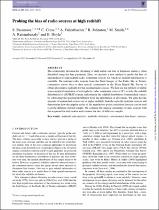JavaScript is disabled for your browser. Some features of this site may not work without it.
- ResearchSpace
- →
- Research Publications/Outputs
- →
- Journal Articles
- →
- View Item
| dc.contributor.author |
Passmoor, S

|
|
| dc.contributor.author |
Cress, C

|
|
| dc.contributor.author |
Faltenbacher, A

|
|
| dc.contributor.author |
Johnston, R

|
|
| dc.contributor.author |
Smith, M

|
|
| dc.contributor.author |
Ratsimbazafy, A

|
|
| dc.contributor.author |
Hoyle, B

|
|
| dc.date.accessioned | 2015-05-25T10:47:56Z | |
| dc.date.available | 2015-05-25T10:47:56Z | |
| dc.date.issued | 2012-11 | |
| dc.identifier.citation | Passmoor, S, Cress, C, Faltenbacher, A, Johnston, R, Smith, M, Ratsimbazafy, A, Hoyle, B. 2012. Probing the bias of radio sources at high redshift. Monthly Notices of the Royal Astronomical Society, vol 429(3), pp 2183-2190 | en_US |
| dc.identifier.issn | 0035-8711 | |
| dc.identifier.uri | http://hdl.handle.net/10204/7966 | |
| dc.description | Copyright: 2012 Oxford University Press | en_US |
| dc.description.abstract | The relationship between the clustering of dark matter and that of luminous matter is often described using the bias parameter. Here, we provide a new method to probe the bias of intermediate-to-high-redshift radio continuum sources for which no redshift information is available. We matched radio sources from the Faint Images of the Radio Sky at Twenty centimetres survey data to their optical counterparts in the Sloan Digital Sky Survey to obtain photometric redshifts for the matched radio sources. We then use the publicly available semi-empirical simulation of extragalactic radio continuum sources (S3) to infer the redshift distribution for all FIRST sources and estimate the redshift distribution of unmatched sources by subtracting the matched distribution from the distribution of all sources. We infer that the majority of unmatched sources are at higher redshifts than the optically matched sources and demonstrate how the angular scales of the angular two-point correlation function can be used to probe different redshift ranges. We compare the angular clustering of radio sources with that expected for dark matter and estimate the bias of different samples. | en_US |
| dc.language.iso | en | en_US |
| dc.publisher | Oxford University Press | en_US |
| dc.relation.ispartofseries | Workflow;10445 | |
| dc.subject | Data analysis | en_US |
| dc.subject | Statistical– astronomical data bases | en_US |
| dc.subject | Surveys | en_US |
| dc.title | Probing the bias of radio sources at high redshift | en_US |
| dc.type | Article | en_US |
| dc.identifier.apacitation | Passmoor, S., Cress, C., Faltenbacher, A., Johnston, R., Smith, M., Ratsimbazafy, A., & Hoyle, B. (2012). Probing the bias of radio sources at high redshift. http://hdl.handle.net/10204/7966 | en_ZA |
| dc.identifier.chicagocitation | Passmoor, S, C Cress, A Faltenbacher, R Johnston, M Smith, A Ratsimbazafy, and B Hoyle "Probing the bias of radio sources at high redshift." (2012) http://hdl.handle.net/10204/7966 | en_ZA |
| dc.identifier.vancouvercitation | Passmoor S, Cress C, Faltenbacher A, Johnston R, Smith M, Ratsimbazafy A, et al. Probing the bias of radio sources at high redshift. 2012; http://hdl.handle.net/10204/7966. | en_ZA |
| dc.identifier.ris | TY - Article AU - Passmoor, S AU - Cress, C AU - Faltenbacher, A AU - Johnston, R AU - Smith, M AU - Ratsimbazafy, A AU - Hoyle, B AB - The relationship between the clustering of dark matter and that of luminous matter is often described using the bias parameter. Here, we provide a new method to probe the bias of intermediate-to-high-redshift radio continuum sources for which no redshift information is available. We matched radio sources from the Faint Images of the Radio Sky at Twenty centimetres survey data to their optical counterparts in the Sloan Digital Sky Survey to obtain photometric redshifts for the matched radio sources. We then use the publicly available semi-empirical simulation of extragalactic radio continuum sources (S3) to infer the redshift distribution for all FIRST sources and estimate the redshift distribution of unmatched sources by subtracting the matched distribution from the distribution of all sources. We infer that the majority of unmatched sources are at higher redshifts than the optically matched sources and demonstrate how the angular scales of the angular two-point correlation function can be used to probe different redshift ranges. We compare the angular clustering of radio sources with that expected for dark matter and estimate the bias of different samples. DA - 2012-11 DB - ResearchSpace DP - CSIR KW - Data analysis KW - Statistical– astronomical data bases KW - Surveys LK - https://researchspace.csir.co.za PY - 2012 SM - 0035-8711 T1 - Probing the bias of radio sources at high redshift TI - Probing the bias of radio sources at high redshift UR - http://hdl.handle.net/10204/7966 ER - | en_ZA |






